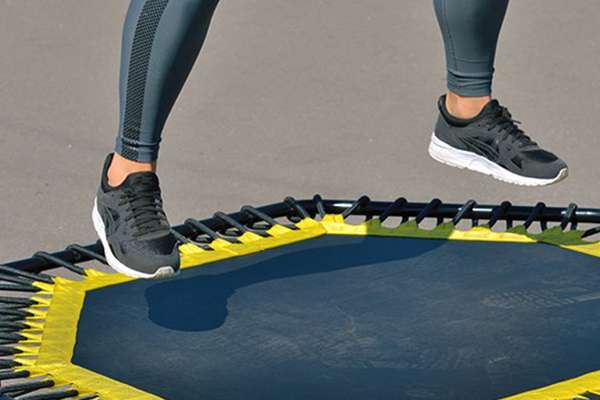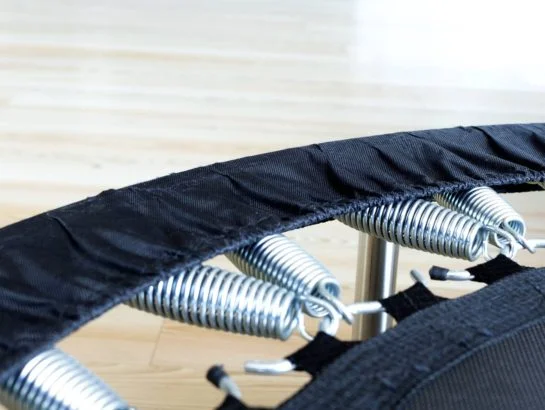How to Fix a Sagging Rebounder
Knowing how to fix a sagging rebounder is vital for getting the most out of this piece of gym equipment. Granted, it’ll take a few years of constant use before it starts to sag, but you’ll hardly want to buy a new one if it happens.
If you are in the position check out our article on the best rebounders on the market today.
In this article, we’ll go over the various options you have for how to fix a sagging rebounder.
Ready to start your rebounder weight loss journey? Try out our 8-week rebounder program!

Why Does My Trampoline Sag?
A trampoline will sag after continued use, usually because the springs or bungees have lost elasticity. Over time, they become overstretched, meaning they don’t have the same level of rebound as they once did.
Similarly, the rebounder mat can sag because it stretches through continuous use. The logic is exactly the same as with the springs because the trampoline’s mat will have some level of elasticity in it.

In fact, the mat will typically begin to sag first. It receives the full impact of you jumping, whereas the springs or bungee cords share the impact among them. Springs also have more elasticity than the mat, meaning it takes longer for them to overstretch.
How to Fix Sagging Trampoline Net
Note that the following steps are for a rebounder but follow the same steps for fixing a sagging trampoline net as its similar structure.
The first step in fixing a sagging rebounder is working out what’s sagging. If it’s the jump mat, you should notice it sagging in the middle. But if it’s the springs, you should feel it bouncing a bit less.

To fix a sagging mat, the easiest solution is to buy a new one. There’s not much you can do to return elasticity to a piece of material, unfortunately. Most manufacturers should sell replacements, or you could buy a generic one.
If the issue is the springs or bungee cords, your best bet is to tighten them. To tighten bungee cords, look for the knots holding them in place. All you need to do is untie and retie these knots, pulling the cords tighter.
Can You Tighten a Rebounder?
Tightening springs is a bit more complicated and requires tools. The springs are held in place by knot heads, which you can tighten using vice grip pliers. You undo the knot and retie the cord so it’s tighter. This will account for the loss of tension in the spring itself.
Alternatively, you could try crossing the springs over in sets of two, so they form an X shape. This might not be possible on smaller rebounders but will again account for a loss of tension.
Here is a useful video on tightening a rebounder:
The final option, if none of these is viable, would be to buy new springs. Metal springs can be quite expensive, though, so it might be more sensible to just buy a new rebounder trampoline.
How to Tighten Trampoline Mat
The trampoline mat is very durable and can withstand resistance over time, but over time they do lose their bounce. Before considering replacing the mat you should try to tighten the trampoline mat. To tighten the cords surrounding the trampoline mat follow these steps:
- Open up the grip pliers and wrap masking taper around the sides of the pliers jaws, these should be 1/8 inches apart.
- Get someone to help you to flip the trampoline 180 degrees on its back
- Take one of the nearest knot blocks and pull the cord inwards towards the middle of the mat
- Grip the cord using your pliers where the knot block meets the cord. Doing this stops the cord from slipping away.
- Using needle nose pliers, loosen the overhead knot at the end of the bounce cord. You can tie an overhead knot near the knot block and the closer you tighten it the tighter the cord will be. Once its suitably tighten release the pliers.
- Follow the above process for each knot and priorities tightening the loosest knots.
Final Thoughts on Fixing a Sagging Rebounder
You should now have enough options for how to fix a sagging rebounder. The most important step is to diagnose where the sag comes from, as this’ll affect how you fix it.
While it can be good to repair an ageing trampoline, if you have to replace the mat and springs, it’s definitely easier to just buy a new one!
An ex-triathlete, fitness coach and writer with a Masters in Sports Physiology. Fitness is my passion and I've had my fair share of home fitness equipment tried and tested!




One Comment